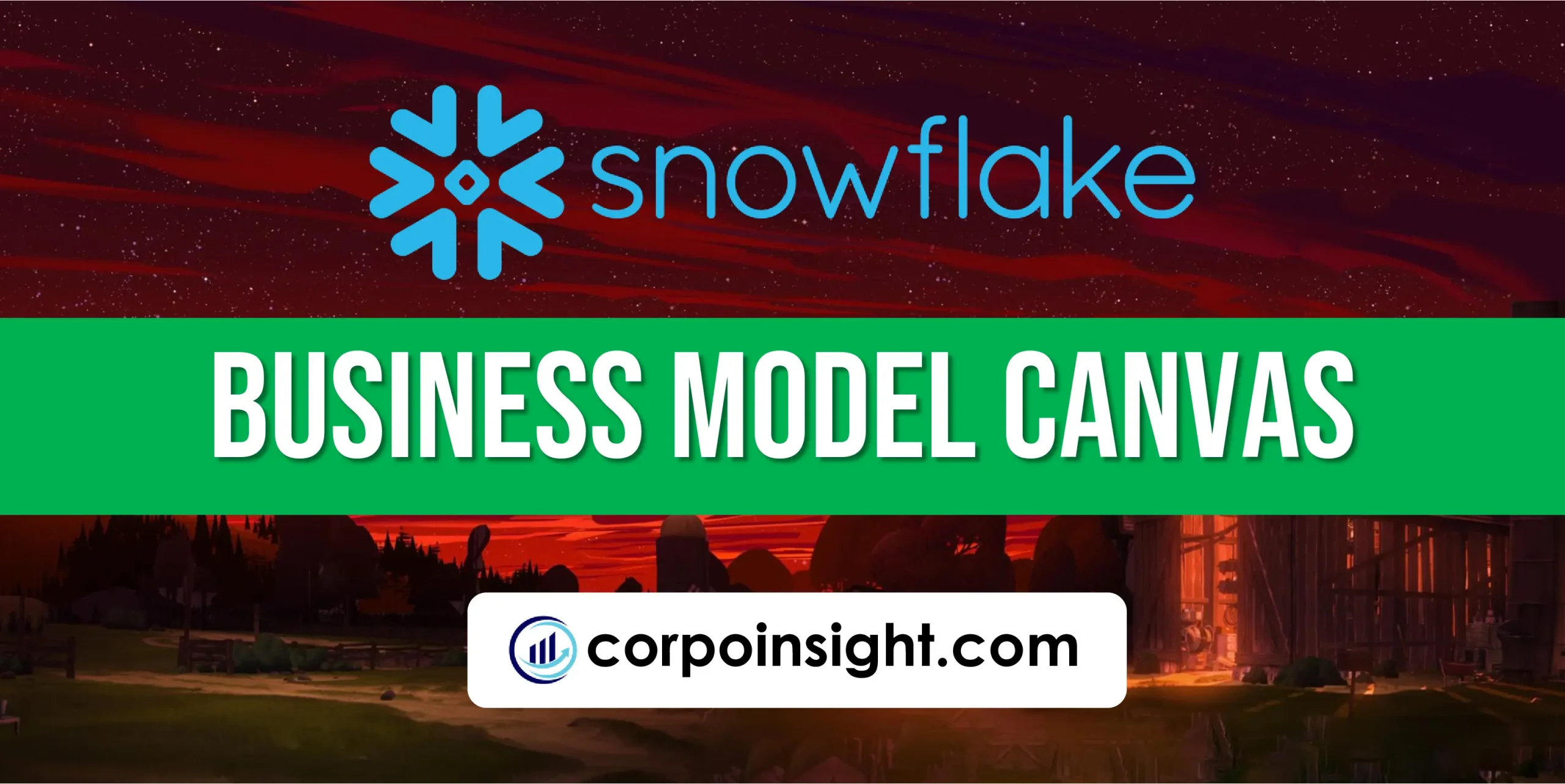Snowflake Business Model Canvas 2024
Despite being a relatively young company, Snowflake, with its innovative cloud data platform architecture separating compute from storage and enabling seamless scalability and its disruptive consumption-based pricing model, has rapidly ascended as a formidable force reshaping the data warehousing and analytics landscape. Learning the Snowflake Business Model Canvas is our goal here, and we will identify its customer segments, value proposition, revenue streams, channels, customer relationships, key activities, key resources, key partners, and cost structure.
Interesting fact!
The company’s first major funding round, a $26 million Series B in 2014, was led by Redpoint Ventures, which had previously backed companies like Netflix and Twilio.
Snowflake Competitors
Amazon Redshift | Google BigQuery | Microsoft Azure Synapse Analytics | Oracle Autonomous Data Warehouse | Teradata | IBM Db2 | SAP HANA | Databricks | Denodo | Cloudera
Customer Segments – Snowflake Business Model Canvas
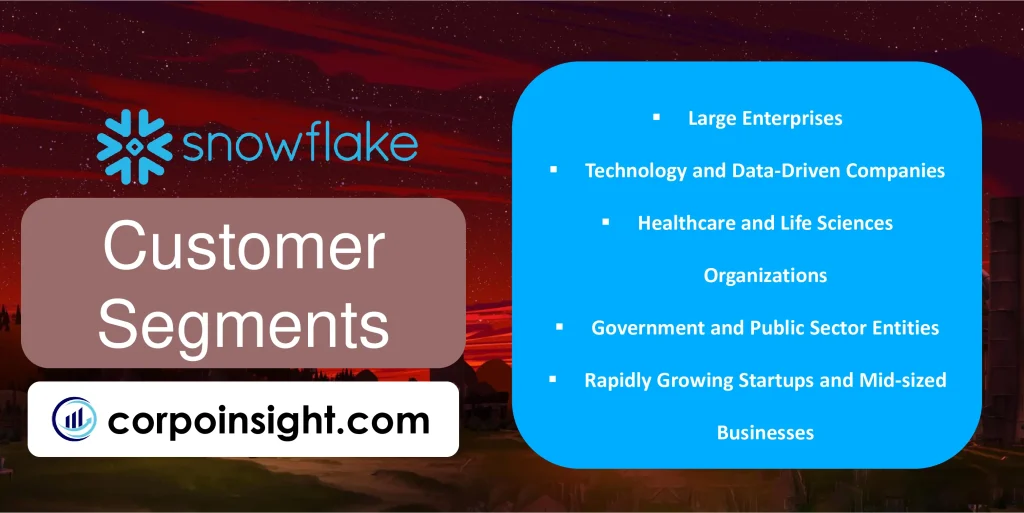
1. Large Enterprises: Snowflake’s ability to handle massive data volumes and its scalable architecture have attracted global corporations, such as Capital One, Deliveroo, and Adobe, which require robust data analytics capabilities to drive informed decision-making and gain a competitive edge in their respective industries.
2. Technology and Data-Driven Companies: With its cloud-based platform and seamless integration with major cloud providers, Snowflake has become an indispensable tool for technology giants like DoorDash and Dropbox, enabling them to leverage data effectively and fuel innovation while maintaining operational agility.
3. Healthcare and Life Sciences Organizations: Recognizing the importance of data in advancing medical research and patient care, companies like Novartis and Particle Health have embraced Snowflake’s secure and compliant platform, facilitating collaborative data sharing and accelerating the pace of scientific discoveries.
4. Government and Public Sector Entities: Driven by the need for efficient data management and analysis, government agencies and public sector organizations, such as the USA Department of Veterans Affairs and the UK’s National Health Service, have adopted Snowflake’s solutions to enhance operational efficiency and deliver better services to citizens.
5. Rapidly Growing Startups and Mid-sized Businesses: Snowflake’s pay-as-you-go pricing model and ease of use have made it an attractive choice for startups and mid-sized businesses seeking to leverage the power of data without substantial upfront investments, enabling them to scale their operations seamlessly as their data needs evolve.
Value Proposition – Snowflake Business Model Canvas
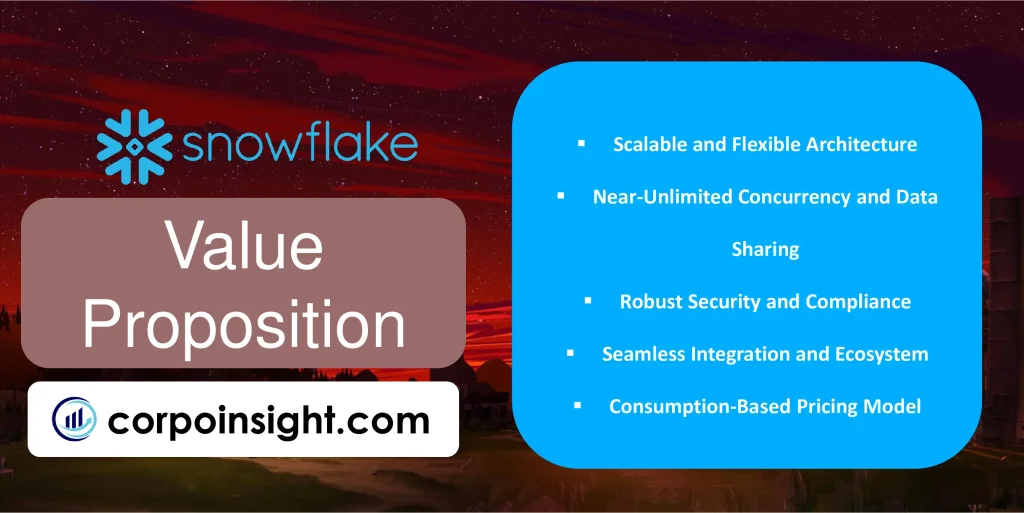
1. Scalable and Flexible Architecture: Snowflake’s unique architecture separates storage and computing, allowing organizations to scale resources up or down seamlessly based on their evolving data needs, ensuring optimal performance and cost-efficiency without compromising analytical capabilities.
2. Near-Unlimited Concurrency and Data Sharing: With its multi-cluster shared data architecture, Snowflake enables near-unlimited concurrent users and workloads, facilitating real-time data sharing and collaboration across teams, departments, and even external partners, fostering data-driven decision-making throughout the organization.
3. Robust Security and Compliance: Snowflake’s cloud-built architecture, coupled with advanced security features like always-on encryption, secure data sharing, and comprehensive compliance certifications (HIPAA, PCI-DSS, SOC 2), ensures organizations can confidently manage and analyze their most sensitive data without compromising on data privacy and regulatory compliance.
4. Seamless Integration and Ecosystem: By integrating seamlessly with popular data sources, BI tools, and cloud platforms, Snowflake empowers organizations to leverage their existing technology investments, streamlining data pipelines and fostering a collaborative data ecosystem that drives innovation and agility.
5. Consumption-Based Pricing Model: Departing from traditional software licensing models, Snowflake’s pay-per-second pricing structure aligns costs with usage, enabling organizations to optimize their data infrastructure expenses while avoiding over-provisioning or under-utilizing resources.
Revenue Streams – Snowflake Business Model Canvas
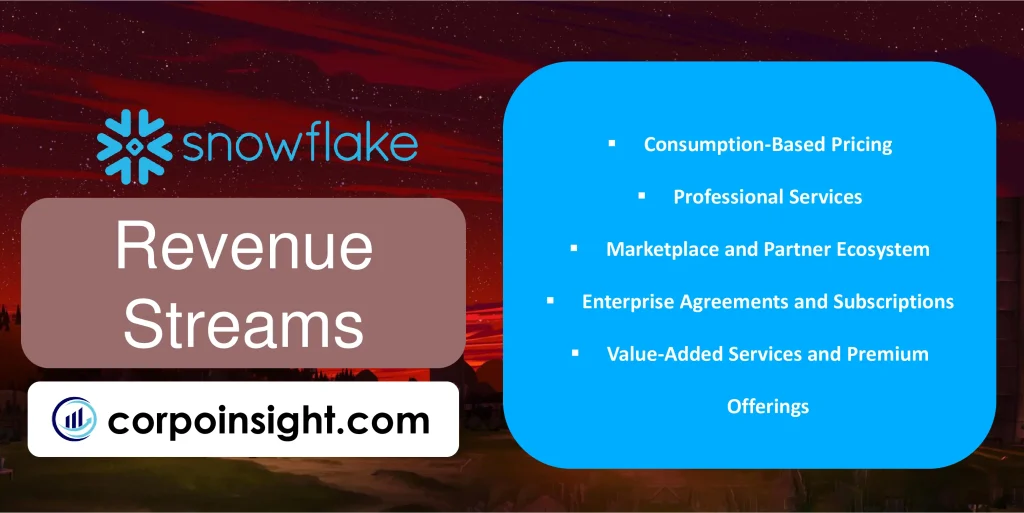
1. Consumption-Based Pricing: Snowflake’s primary revenue stream is derived from its consumption-based pricing model, where customers are charged based on the amount of data storage and compute resources they consume, aligning costs with usage and enabling organizations to optimize their expenditures efficiently.
2. Professional Services: To complement its core product offering, Snowflake generates additional revenue through professional services, including implementation support, data migration, and custom solution development, catering to organizations that require expert guidance and tailored solutions to maximize the value of their data investments.
3. Marketplace and Partner Ecosystem: Snowflake has established a thriving ecosystem of technology partners and data providers, enabling customers to access and integrate third-party data sources, tools, and services directly through the Snowflake Marketplace, generating revenue through partnership agreements and commission-based models.
4. Enterprise Agreements and Subscriptions: For larger organizations with predictable and significant data needs, Snowflake offers enterprise agreements and subscription-based pricing models, providing customers with cost-effective, long-term commitments and generating recurring revenue streams for the company.
5. Value-Added Services and Premium Offerings: As its platform matures, Snowflake explores opportunities to introduce value-added services and premium offerings, such as advanced data governance tools, managed services, and specialized industry-specific solutions, potentially unlocking new revenue streams while meeting evolving customer demands.
Channels – Snowflake Business Model Canvas
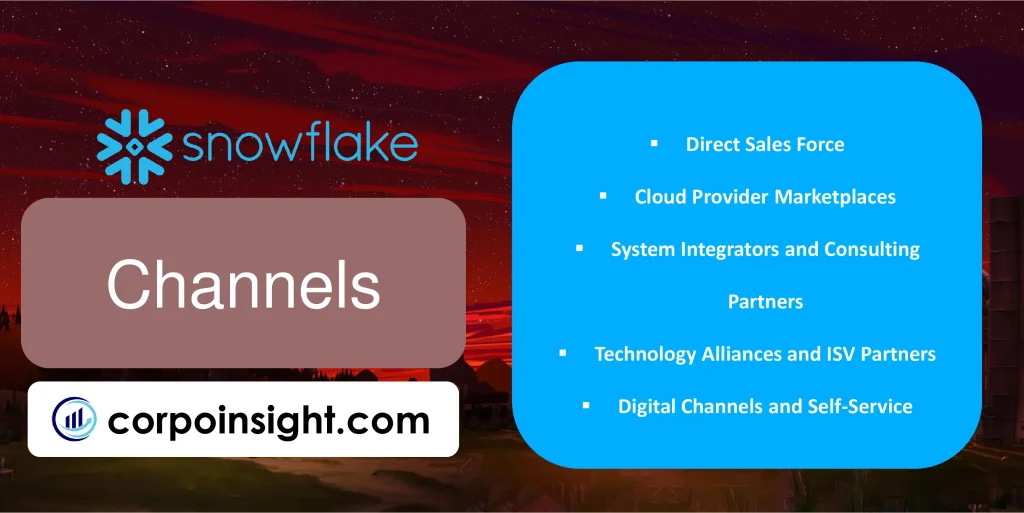
1. Direct Sales Force: Snowflake’s direct sales team, comprising experienced sales professionals and solution architects, is crucial in engaging with large enterprises and strategic accounts, offering personalized guidance and tailored solutions to meet their unique data analytics requirements.
2. Cloud Provider Marketplaces: Recognizing the growing adoption of cloud computing, Snowflake has strategically partnered with major cloud providers like Amazon Web Services, Microsoft Azure, and Google Cloud Platform, making its platform readily available through their respective marketplaces and leveraging their extensive customer bases.
3. System Integrators and Consulting Partners: To expand its reach and deliver specialized expertise, Snowflake has cultivated a robust ecosystem of system integrators and consulting partners, enabling organizations to access professional services, implementation support, and industry-specific solutions through trusted advisors.
4. Technology Alliances and ISV Partners: Snowflake’s technology alliances and partnerships with independent software vendors (ISVs) have created a vibrant ecosystem, allowing customers to seamlessly integrate third-party tools, applications, and data sources with the Snowflake platform, enhancing its value proposition.
5. Digital Channels and Self-Service: While maintaining a strong direct sales presence, Snowflake has also embraced digital channels, including its website, online resources, and self-service portals, catering to the growing demand for self-service analytics and enabling organizations of all sizes to explore and adopt its solutions efficiently.
Customer Relationships – Snowflake Business Model Canvas
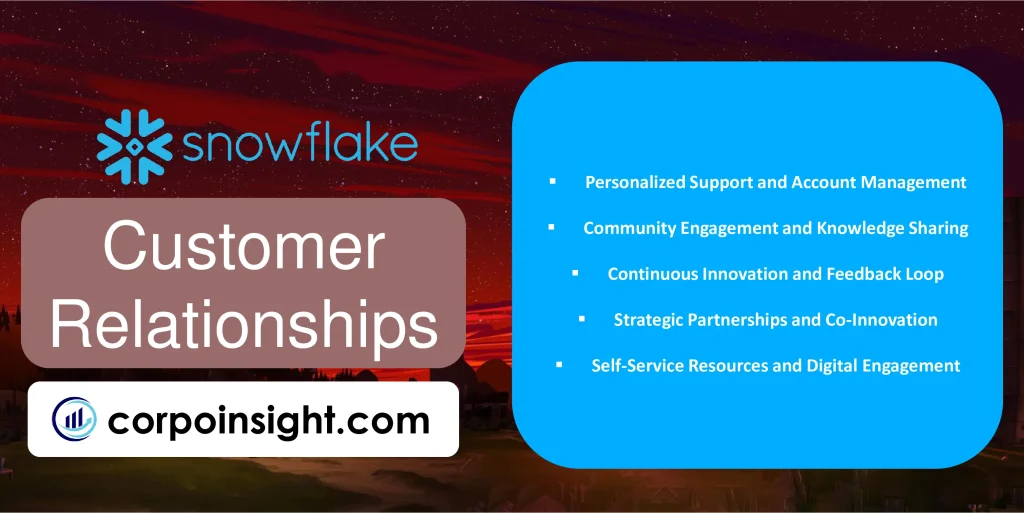
1. Personalized Support and Account Management: Snowflake invests heavily in building strong relationships with its customers, offering dedicated account managers and support teams that provide personalized attention, addressing unique needs, and ensuring seamless adoption and ongoing success with the platform.
2. Community Engagement and Knowledge Sharing: Recognizing the value of fostering a vibrant user community, Snowflake actively encourages knowledge sharing through forums, user groups, and events like the annual “Snowflake Summit,” facilitating peer-to-peer learning and fostering a sense of belonging among its customers.
3. Continuous Innovation and Feedback Loop: Snowflake maintains close relationships with its customers, actively soliciting feedback and incorporating their insights into its product roadmap, ensuring its platform evolves to meet the ever-changing demands of the data analytics landscape.
4. Strategic Partnerships and Co-Innovation: Snowflake collaborates with key technology partners, system integrators, and industry leaders to co-develop tailored solutions and services, enabling customers to leverage the collective expertise and cutting-edge innovations across the ecosystem.
5. Self-Service Resources and Digital Engagement: While emphasizing personalized support, Snowflake also provides robust self-service resources, including comprehensive documentation, online training, and digital engagement channels, empowering customers to explore, learn, and optimize their platform use independently.
Key Activities – Snowflake Business Model Canvas
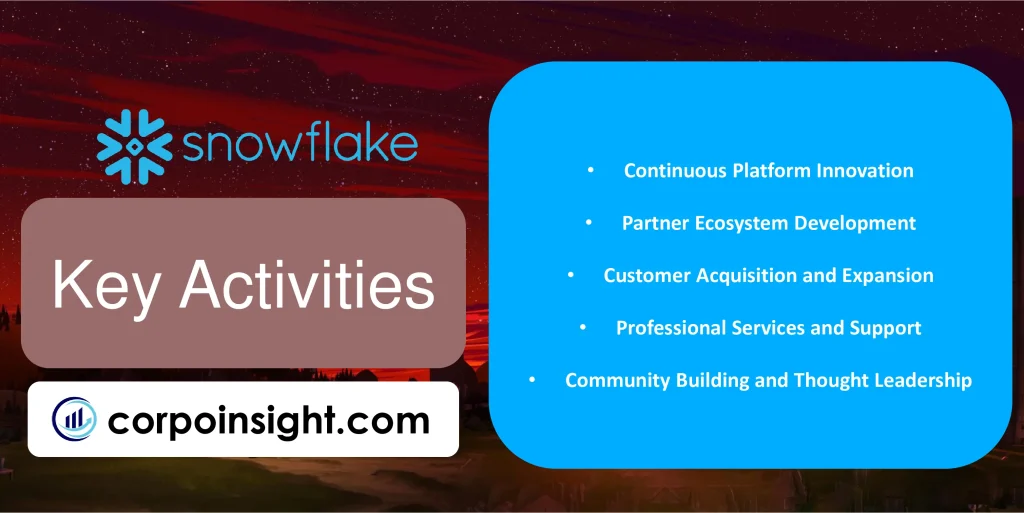
1. Continuous Platform Innovation: Snowflake’s relentless pursuit of innovation is a core activity, with its engineering teams continuously enhancing the platform’s capabilities, performance, and security features, ensuring that customers can leverage the latest advancements in data analytics and cloud computing.
2. Partner Ecosystem Development: Recognizing the power of collaboration, Snowflake cultivates a robust ecosystem of technology partners, system integrators, and data providers, fostering seamless integrations and co-developing tailored solutions to address customer-specific requirements across industries.
3. Customer Acquisition and Expansion: Snowflake’s sales and marketing teams are dedicated to acquiring new customers and expanding its footprint within existing accounts, leveraging a multi-channel approach that includes direct sales, strategic partnerships, and digital marketing initiatives.
4. Professional Services and Support: Snowflake’s professional services division is crucial in ensuring customer success, offering implementation support, data migration services, and ongoing training and consulting to help organizations maximize the value of their data investments.
5. Community Building and Thought Leadership: Snowflake actively engages in community-building activities, hosting events, webinars, and user groups while contributing to industry thought leadership through whitepapers, case studies, and relevant conferences and forums.
Key Resources – Snowflake Business Model Canvas

1. Highly Skilled Workforce: Snowflake’s most valuable resource is its talented and experienced workforce, comprising software engineers, data scientists, solution architects, and subject matter experts who collectively drive innovation, deliver exceptional customer service, and enable the company to maintain its technological edge.
2. Proprietary Cloud Data Platform Technology: At the core of Snowflake’s offering is its proprietary cloud data platform technology, which encompasses its unique architecture, advanced data processing capabilities, and robust security features, enabling organizations to leverage the full potential of their data assets.
3. Robust Partner Ecosystem: Snowflake has cultivated a thriving ecosystem of technology partners, system integrators, and data providers, serving as a valuable resource that expands its capabilities, enhances its value proposition, and enables customers to access a wide range of complementary solutions.
4. Intellectual Property and Patents: With a strong focus on innovation, Snowflake has amassed a significant portfolio of intellectual property and patents, protecting its core technologies and positioning the company as a leader in the cloud data analytics space.
5. Financial Resources and Investor Backing: Snowflake’s financial resources, bolstered by strong investor backing and a successful initial public offering (IPO), provide the necessary capital to support ongoing research and development, strategic acquisitions, and expansion into new markets and verticals.
Key Partners – Snowflake Business Model Canvas
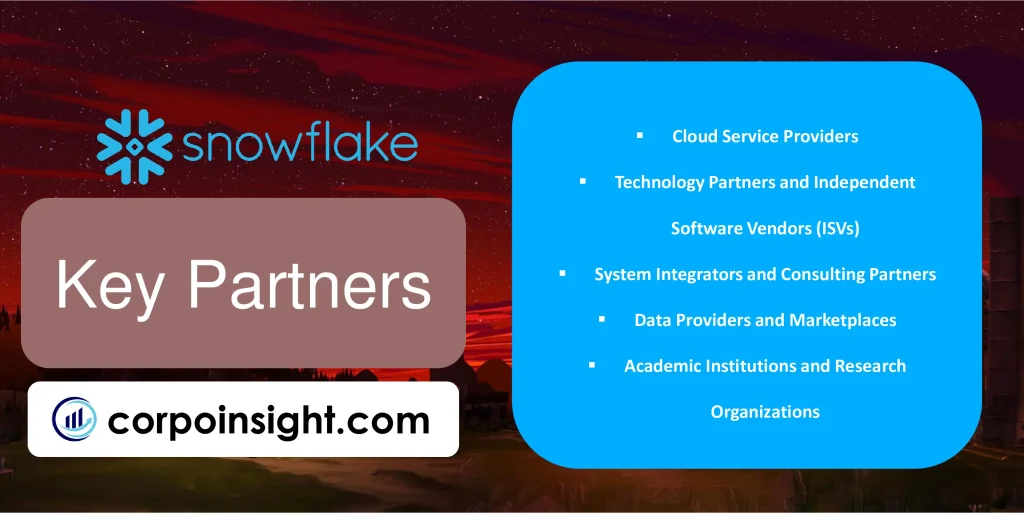
1. Cloud Service Providers: Snowflake has established strategic partnerships with leading cloud service providers such as Amazon Web Services (AWS), Microsoft Azure, and Google Cloud Platform, enabling seamless integration and deployment of its platform on these highly scalable and secure cloud infrastructures.
2. Technology Partners and Independent Software Vendors (ISVs): Snowflake collaborates closely with a diverse range of technology partners and ISVs, including industry leaders like Salesforce, Tableau, and Databricks, to develop integrated solutions that leverage the strengths of each partner’s offerings, providing customers with enhanced functionality and value.
3. System Integrators and Consulting Partners: To deliver specialized expertise and implementation support, Snowflake has cultivated strong relationships with system integrators and consulting partners, such as Accenture, Deloitte, and Slalom, enabling customers to access professional services and industry-specific solutions tailored to their unique requirements.
4. Data Providers and Marketplaces: Recognizing the increasing demand for data-driven insights, Snowflake has partnered with leading data providers and marketplaces, such as Snowflake Data Marketplace and Precisely, offering customers access to curated third-party data sources that can be seamlessly integrated into their analytics workflows.
5. Academic Institutions and Research Organizations: To drive innovation and foster talent development, Snowflake collaborates with academic institutions and research organizations, supporting data-driven research initiatives, providing access to its platform for educational purposes, and cultivating the next generation of data professionals.
Cost Structure – Snowflake Business Model Canvas
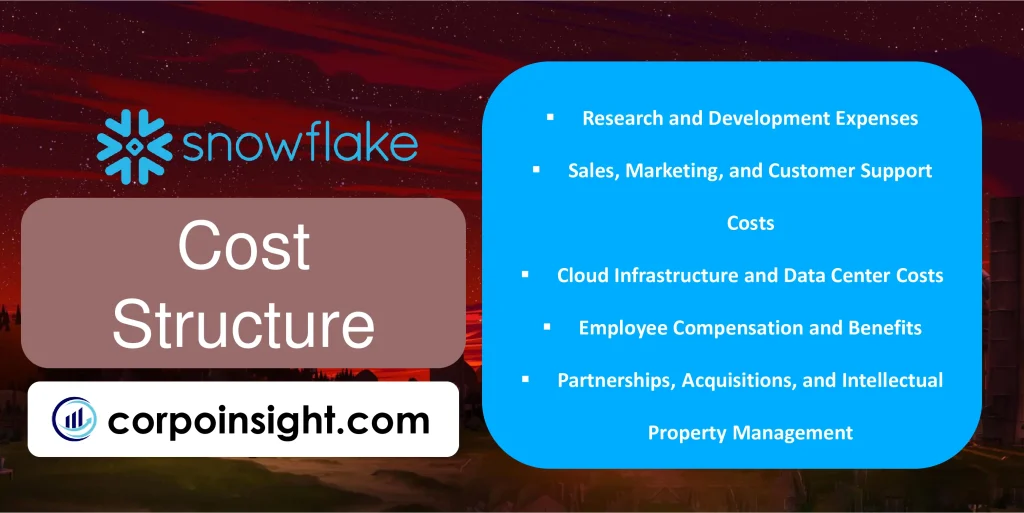
1. Research and Development Expenses: Snowflake invests heavily in research and development activities, allocating a significant portion of its resources to enhance its proprietary cloud data platform, develop new features and functionalities, and maintain its technological edge in the highly competitive data analytics market.
2. Sales, Marketing, and Customer Support Costs: With a strong focus on customer acquisition and retention, Snowflake incurs substantial costs associated with its sales and marketing efforts, including maintaining a global sales force, executing marketing campaigns, and providing comprehensive customer support services.
3. Cloud Infrastructure and Data Center Costs: As a cloud-based platform, Snowflake relies on third-party cloud service providers for its infrastructure needs, incurring costs related to data storage, computing power, and network bandwidth, which can fluctuate based on customer demand and usage patterns.
4. Employee Compensation and Benefits: Attracting and retaining top talent is crucial for Snowflake’s success, leading to significant costs associated with employee salaries, bonuses, stock-based compensation, and benefits, especially in the highly competitive technology sector.
5. Partnerships, Acquisitions, and Intellectual Property Management: Snowflake’s cost structure also encompasses expenses related to maintaining and expanding its partner ecosystem, pursuing strategic acquisitions to augment its capabilities, and protecting its intellectual property through patenting and legal activities.
Summary of Snowflake Business Model Canvas
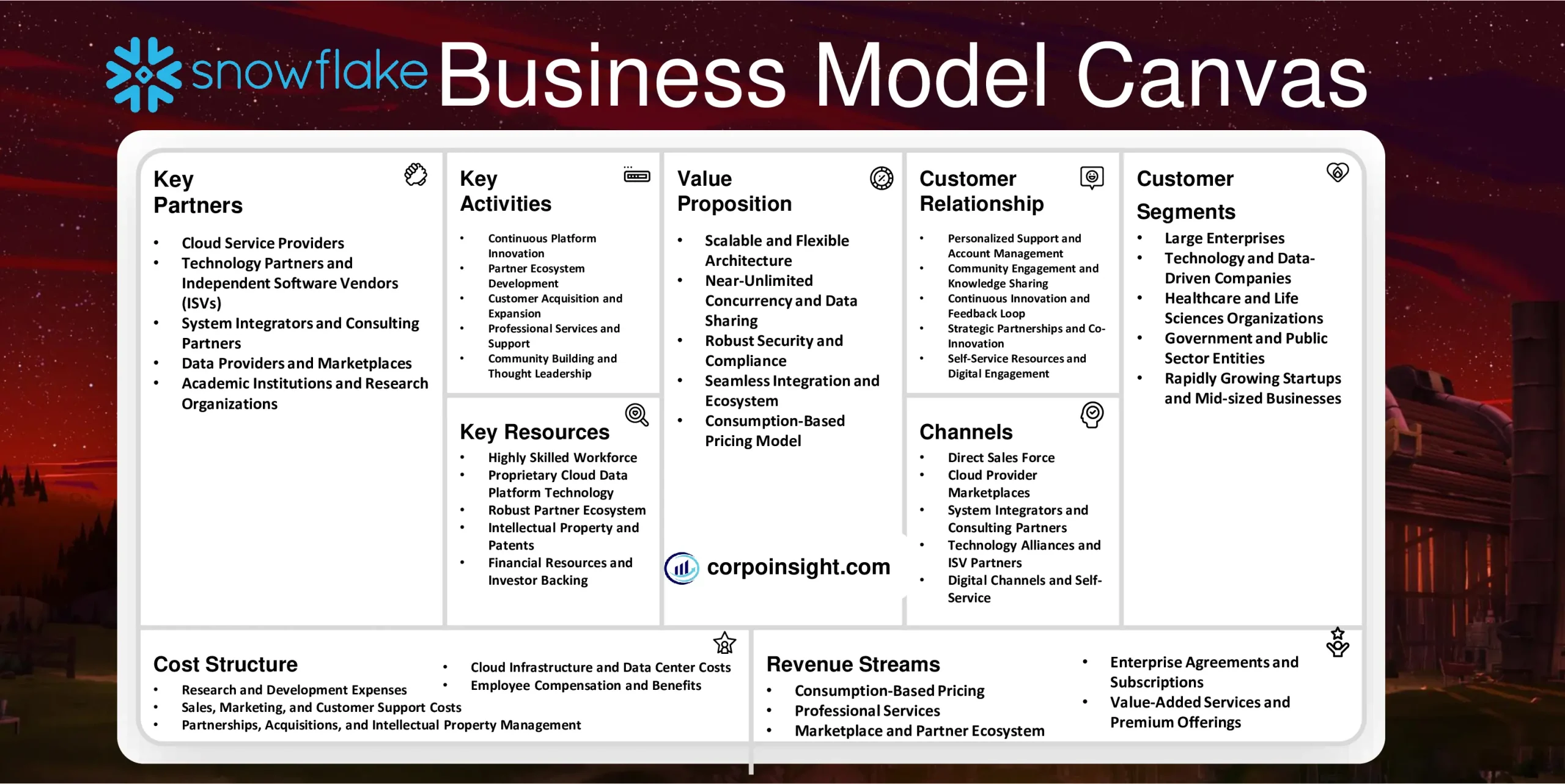
Conclusion on Snowflake Business Model Canvas
Snowflake’s innovative cloud data platform, disruptive consumption-based pricing model, and robust partner ecosystem have propelled its rapid growth. By delivering scalable, secure, and cost-effective data analytics solutions, Snowflake has carved a niche, attracting diverse customers across industries. With a strong focus on continuous innovation, strategic partnerships, and customer success, Snowflake is well-positioned to maintain its leadership in the data analytics market, driving data-driven transformation for organizations worldwide.

I’m Samin Yasar, currently working as a Brand Strategist for one of the world’s leading Prop Firms. I have a passion for content creation and dream of making my own film one day.

